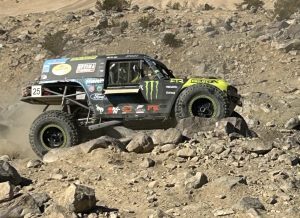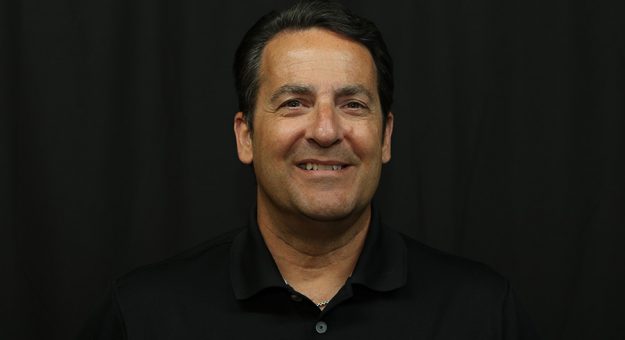MOORESVILLE, N.C. — The Progressive King of the Hammers powered by Optima Batteries is the motorsports version of Burning Man — 100,000 people living for two weeks on a desolate Mojave Desert lakebed in the unincorporated community of Johnson Valley, Calif.
Located about two hours outside of Palm Springs, base camp for the event is known as Hammertown. It’s a temporary city that springs up every year in the middle of the lakebed. There are no permanent structures, but there are streets, a pit area, a media center, manufacturer midways and live concerts every night. There is everything fans are accustomed to having at any permanent race track. However, it is all brought in and taken back out by the King of the Hammers staff and competitors.
King of the Hammers is the gnarliest off-road race in the United States, but this isn’t your standard off-road race where competitors speed through the desert while trying to avoid cactus and other obstacles. At Hammers, vehicles need to be able to scream across the desert floor at speeds up to 150 mph but also climb up into the mountains where things become challenging and the race is won or lost.
The race vehicles also have to be able to crawl up and down boulder-strewn canyons with names such as Sledgehammer, Jackhammer, Chocolate Thunder and Turkey Claw. Vehicles resemble high-horsepower spiders as they inch their way up, over and around massive rock formations.

If the vehicle’s massive shocks and sticky tires don’t provide enough grip to climb to the top, the co-driver jumps out and hooks up a winch that pulls the machine past the combative obstacle. Winch points are laid out by the course workers and spotted and tested by the racers while pre-running the course.
The baddest, fastest most technologically advanced category competing at Hammers are the super-trick Ultra4 4400 Unlimited machines with engines pumping out between 900 and 1,000 horsepower. Suspensions have 24 to 26 inches of travel mounted with 40 to 42-inch tires. These behemoths can cost upward of $250,000 new and ready to be thrashed in the desert.
The race consists of three laps around a course that is just short of 100 miles per lap. It’s a day-long physical beating for the racers, with the first machine leaving the starting area at 8 a.m. The last finisher crossed the line in Hammertown around 10 p.m.
There is a category for everybody from motorcycles and side-by-sides to the Everyman Challenge, which is exactly what it sounds — a run-whatcha-brung class for the budget-conscious racer. It all wraps up with the Nitto Race of Kings, which was won by Raul Gomez for the second consecutive year.
King of the Hammers has a way of getting under your skin, and I don’t mean the dust. There is something about the desert and the energy of Hammertown that draws you back year after year. Checking it out if you’re looking for a different type of racing experience that you will never forget. See you on the lakebed.
■ A 180-degree reversal from King of the Hammers is the Rolex 24 At Daytona. I’ve attended numerous twice-around-the-clock affairs at the World Center of Racing and it remains the biggest and most important sports car race in North America.
This year’s race was spectacular! A record crowd moved freely from the paddock to the grid, the grandstands and the infield in an effort to see the action from every angle IMSA and its competitors could provide. Not only was the crowd large, but there was an incredible energy throughout the week.
The stunning new IMSA GTP machines looked fantastic whether they were sitting still or blasting along the high banks of the superspeedway section of the 3.56-mile road course. Getting the new class of hybrid prototype cars on to the race track took a lot of hard work by the leadership of IMSA, the ACO, the teams and the manufacturers.
Fans of sports car racing have a lot to look forward to this season with the Mobil 1 Twelve Hours of Sebring and the 24 Hours of Le Mans still ahead.
■ Ken Clapp has literally done it all in motorsports, from working as a gopher for race teams as a teenager to serving a lengthy stint as NASCAR’s vice president of Western Operations. He is also a mentor and dear friend of mine.
Fortunately, for those of us who have a passion for racing history, Clapp sat down with SPEED SPORT’s outstanding columnist Bones Bourcier to produce “Sea to Shining Sea.”
This book is not only extremely entertaining, but it’s one of the most important books I’ve read in recent years. I know that’s a big statement but here’s why: Clapp was literally there alongside Bill France, Bill France Jr., Brian France and many of NASCAR’s top executives as this country’s premier sanctioning body rose from humble beginnings and, eventually, expanded from shore to shore as “Big Bill” envisioned. It was a dream that never would have happened if not for Clapp’s leadership on the West Coast.
Not only will readers learn about how NASCAR grew, they will laugh at the hilarious stories that happened along the way. They will also gain tremendous insight into industry visionaries such as Bob Barkhimer and Margo Burke, who along with legends such as J.C. Agajanian helped develop the motorsports industry in the western part of the country.
Congratulations to Clapp and Bourcier for putting all of this incredible history into a book so these stories will be preserved. Get year copy from the great folks at coastal181.com.
This story appeared in the March 8, 2023 edition of the SPEED SPORT Insider.

